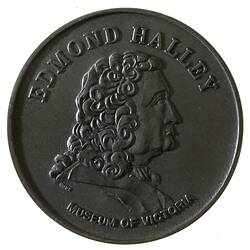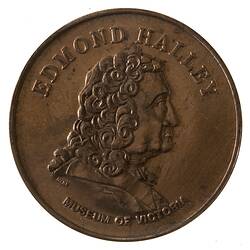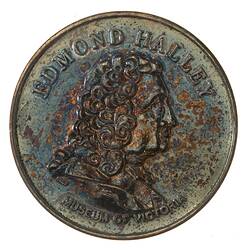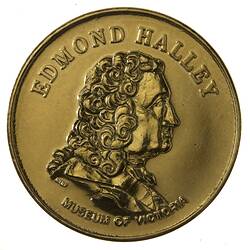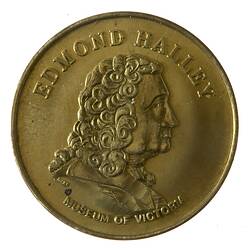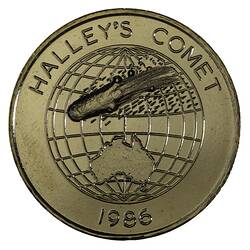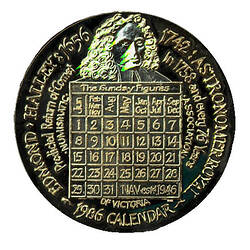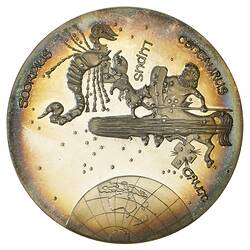Edmond Halley was born in Hagerston (near London) in 1656. He was educated at St. Paul's School, 1671-73, and Queen's College, Oxford University, 1673-6, leaving without a BA. In 1679, however, he was awarded an MA by a royal mandate.
Halley began serious astronomical observations as an undergraduate and published a paper on theoretical astronomy in the Philosophical Transactions. His father supported his scientific work with an annual allowance of £300 until he was murdered in 1684.
Halley then took a fairly menial position with the Royal Society to support himself, and in 1685-96 served as assistant of the secretaries of the Royal Society. He was Deputy controller of the mint at Chester 1696-98. For the following three years he was naval captain in command of the Paramore, a vessel built explicitly for Halley's scientific expeditions. In 1704 he was appointed Savilian Professor of Geometry at Oxford University, a positon he held until his death. In 1720 he became Astronomer Royal, which he also remained until his death. From 1729 he served as a naval captain on half pay.
Halley is remembered primarily for 'A Synopsis of the Astronomy of Comets', 1705, but made other important contributions including a catalogue of the southern skies (Catalogus stellarum australium, 1678), the method of measuring the astronomical unit via transits of Venus, the establishment of stellar motion and the secular acceleration of the moon. He also published papers in pure mathematics, developed a general theory about the magnetism of the earth, studied the weather, and worked on historical geology, optics and navigation. He is considered the founder of geophysics, especially for his paper on trade winds and his work on tides, and one of the pioneers in social statistics. Halley is today most well known in relation to Halley's Comet. He predicted its return in 1758 and every 75 years thereafter.
Halley was supported by important patrons. Sir Joseph Williamson and Sir Jonas Moore, both governmental officials, backed Halley's expedition to St. Helena. Charles II recommended him to the East India Company and arranged transport to St. Helena for him in 1676. He received a treasury grant of £500 for equipment. Halley expressed his gratitude by dedicating a planisphere of the southern hemisphere stars to Charles II. Halley also had powerful patrons in the navy who sponsored his expeditions in 1698-1701. The Earl of Nottingham, the Secretary of State arranged for the mission to the Austrian empire and then, when he returned, engineered his appointment to the Savilian chair. The Holy Roman Emperor presented him with a valuable diamond ring after his first Austrian mission. Halley owed his position as Astronomer Royal to the Earl of Macclesfield and the Earl of Sunderland. In 1729 it was Queen Caroline who arranged for him to receive the half pay of a naval captain, in order that his income be sufficient.
References:
Galileo Project at Rice University, http://es.rice.edu/ES/humsoc/Galileo/Catalog/Files/halley.html
More Information
-
Keywords
-
Localities
-
Authors
-
Article types

